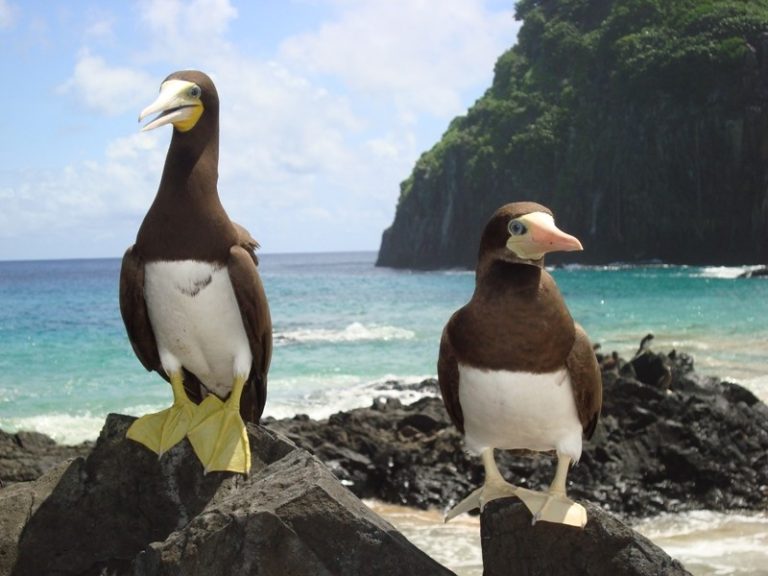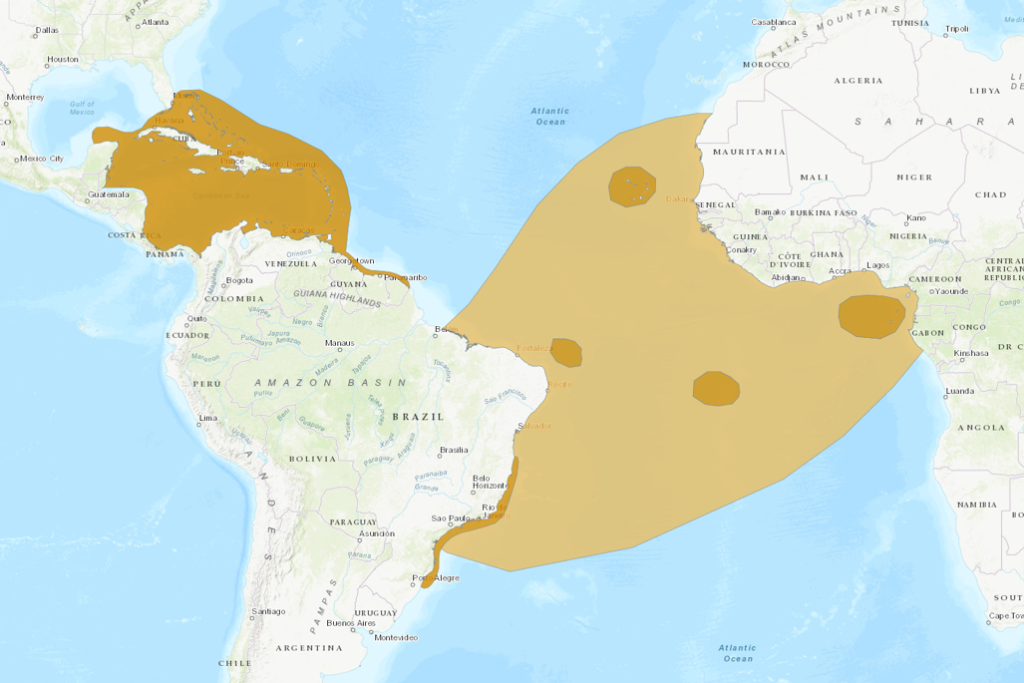Birdfinding.info ⇒ The Atlantic form of Brown Booby is fairly common in much of the Caribbean Basin, especially along the coasts of Puerto Rico and eastward through the Virgin and Leeward Islands. Also locally common along the coast of southeastern Brazil from the Cabo Frio area (Rio de Janeiro) to Florianópolis (Santa Catarina), and in the Cape Verde Islands. Elsewhere it tends to be found mostly around its remote nesting islands, such as Fernando de Noronha, Ascension, St. Helena, and Príncipe. In the U.S., small numbers are present year-round in coastal waters of southern Florida, including Dry Tortugas National Park, where it often perches on channel markers and buoys.
“Atlantic Booby”
Sula leucogaster leucogaster
Tropical Atlantic Ocean. Occurs in both coastal and offshore waters.
Breeding. Nests mainly on cliff ledges, but also uses flat, open ground on remote islands.
Breeds on islands of the Caribbean and in four other regions of the tropical Atlantic: (1) eastern Brazil; (2) northwestern Africa; (3) mid-oceanic islands (Ascension and St. Helena); and (4) the Gulf of Guinea (São Tomé & Príncipe).
The Caribbean population breeds year-round on islets from Arrecife Alacrán (Yucatán) and Isla Contoy (Quintana Roo) to Costa Rica (Isla Uvita), Panama (Bocas del Toro and Colón), and Tobago. In 2009 the total breeding population was estimated at about 10,000 pairs in about 100 colonies. The highest concentration (>40%) was in approximately 25 colonies from Puerto Rico to Anguilla and St. Barthelemy. Other substantial concentrations were in the southern Bahamas, Isla San Andrés (Colombia), Venezuelan offshore islets, the Lesser Antilles (mainly Guadeloupe and the Grenadines), and the southwestern Dominican Republic.
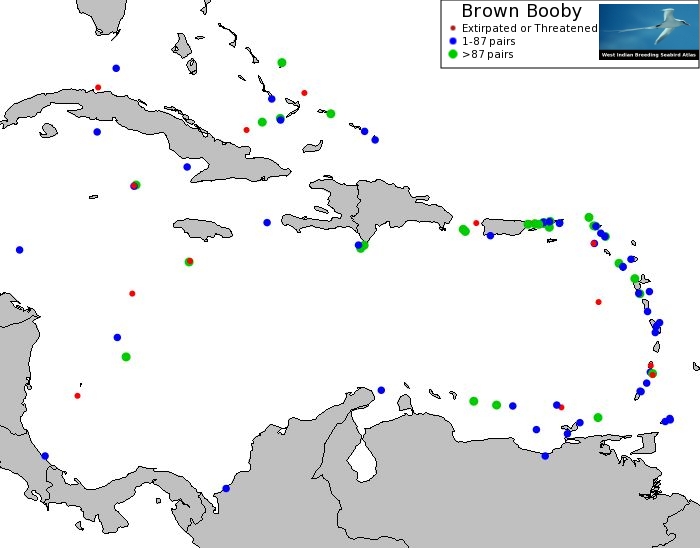
“Atlantic Booby” breeding colonies mapped in the West Indian Breeding Seabird Atlas, 2009. © Will Mackin & David Lee
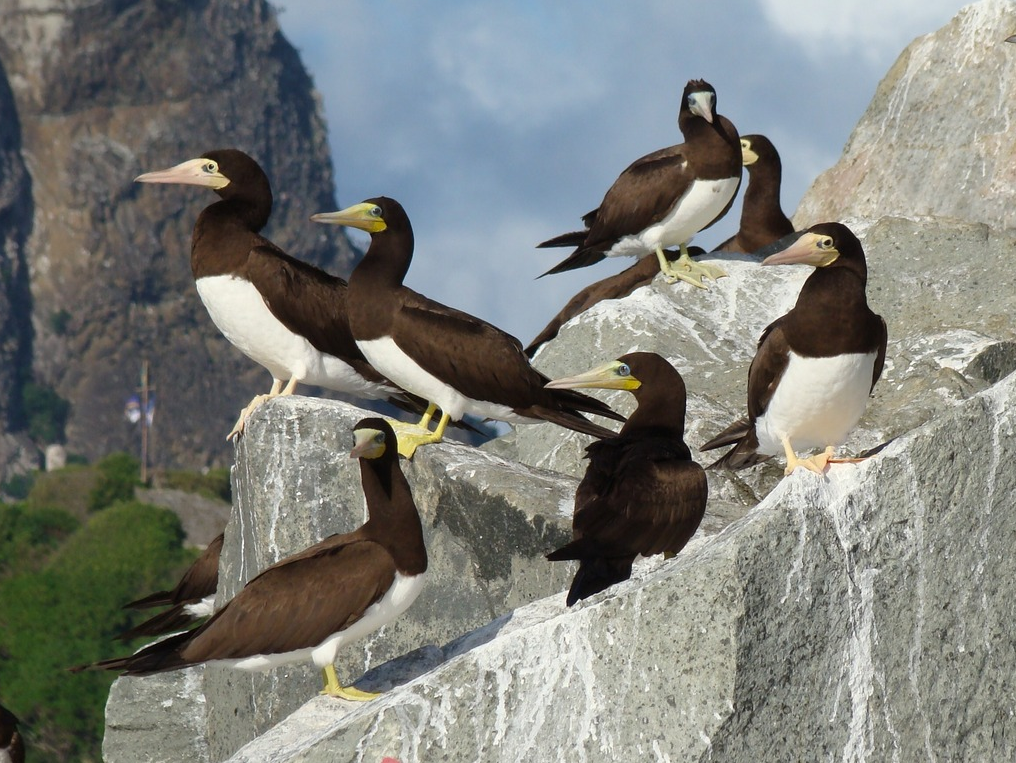
“Atlantic Booby”, S. l. leucogaster, 4 males and 3 females resting near nesting area in Brazil’s Fernando de Noronha archipelago. (March 18, 2011.) © Rafael Antunes Dias
Brazil: nests on Fernando de Noronha (offshore from Rio Grande do Norte), the Abrolhos Islands (southern Bahía), and a few islets between Buzios (Rio de Janeiro) and São Francisco do Sul (Santa Catarina).
Northwestern Africa: Cape Verde (Santiago, Brava, Ilhéus do Rombo, Raso, and Boavista) and along the coast of Senegal (a few pairs at Îles des Madeleines).
Mid-Atlantic Ocean: Ascension Island and St. Helena.
Gulf of Guinea: islets around São Tomé and Príncipe (mostly the latter).
Nonbreeding. Largely resident around its breeding areas, but also disperses more widely across the tropical and subtropical zones of the western Atlantic Ocean, including the Gulf of Mexico.
Stragglers regularly wander north along the eastern coast of the U.S. to Nova Scotia, inland in eastern Texas and the lower Mississippi Valley, south in Brazilian waters to Rio Grande do Sul, and along West African coasts north to Western Sahara and south to Gabon.
More exceptional vagrants have been recorded inland to Nebraska, Iowa, and the Great Lakes, north to Quebec, Newfoundland, and southern Labrador, at sea to Bermuda, the Azores (São Miguel), and Madeira, northeast to the Iberian Peninsula and the British Isles (Cornwall and Ireland), and east into the Mediterranean to Mallorca and northern Italy.
Identification
Similar to the other forms of Brown Booby: dark brown overall, with a crisply defined bright white belly and underwing linings, and pale bill and feet. Females of the three forms are nearly identical, with only subtle differences in bare parts coloration and underwing pattern, while the males are much more distinctive.
Male “Atlantic” typically has mostly yellow-orange facial skin with a dark spot in front of the eye, a horn-colored or straw-yellow bill, often with a slight bluish tint, and yellow-orange feet. The male’s orbital skin is typically bluish and merges with the dark spot in front of the eye to form a small “eyeshadow” mask.
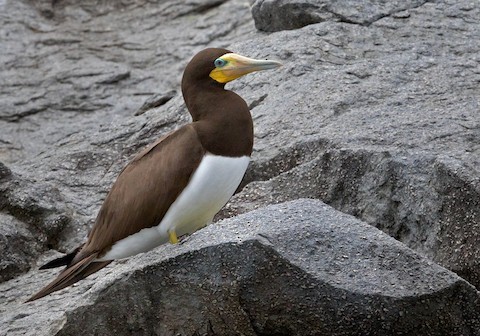
“Atlantic Booby”, S. l. leucogaster, male. (Ilhéu Boné de Jóquei, Príncipe, São Tomé & Príncipe; September 23, 2017.) © Lars Petersson

“Atlantic Booby”, S. l. leucogaster, male. (Fernando de Noronha, Brazil; March 25, 2017.) © Eduardo Augusto Ferreira

“Atlantic Booby”, S. l. leucogaster, male. (Ilhabela, São Paulo, Brazil; June 13, 2015.) © Hector Bottai
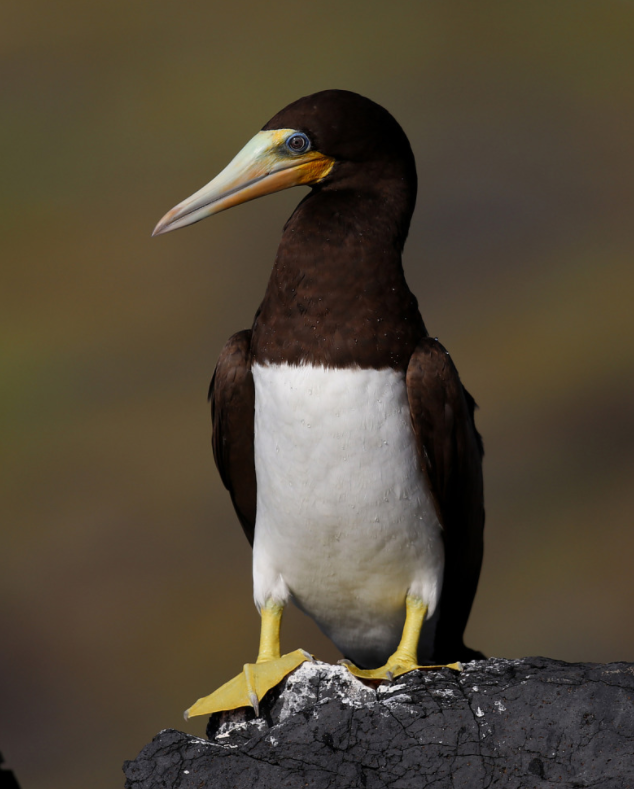
“Atlantic Booby”, S. l. leucogaster, male showing orange-yellow facial skin and small dark, eyeshadow mask. (Fernando de Noronha, Brazil; March 9, 2020.) © Henrique Langenegger
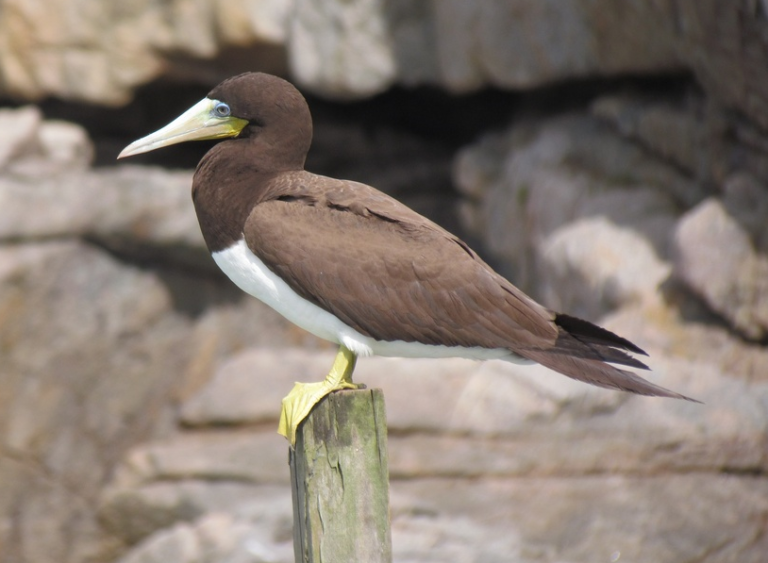
“Atlantic Booby”, S. l. leucogaster, male showing noticeable contrast between darker hood and paler-brown upperparts. (Arraial do Cabo, Rio de Janeiro, Brazil; January 11, 2012.) © Mateus Sales
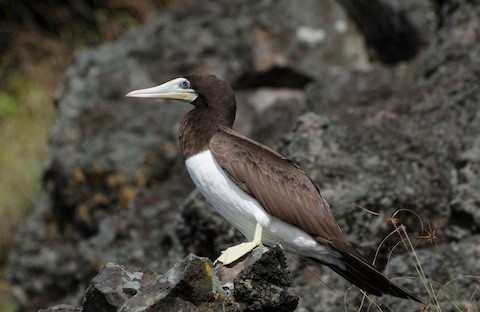
“Atlantic Booby”, S. l. leucogaster, male. (Fernando de Noronha, Brazil; March 31, 2017.) © Eduardo Augusto Ferreira
Female “Atlantic” typically has a pale, slightly pinkish bill, pale yellow facial skin with a dark spot in front of the eye, and pale yellow feet. The female’s facial skin and feet are usually a paler shade of yellow (more whitish, less orange) than the male’s, but this coloration varies and can also be orangish like the typical male’s. Unlike males, the female’s orbital skin (immediately around the eye) is pale-yellow.
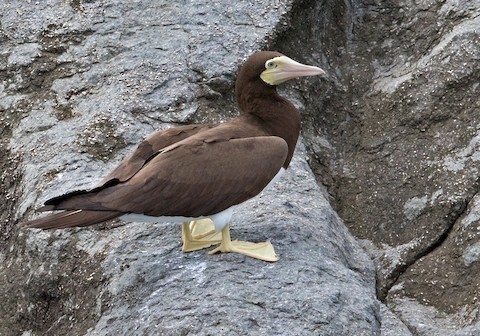
“Atlantic Booby”, S. l. leucogaster, female. (Ilhéu Boné de Jóquei, Príncipe, São Tomé & Príncipe; September 23, 2017.) © Lars Petersson

“Atlantic Booby”, S. l. leucogaster, female. (Lighthouse Trail, Cayman Brac; April 13, 2019.) © Denny Swaby
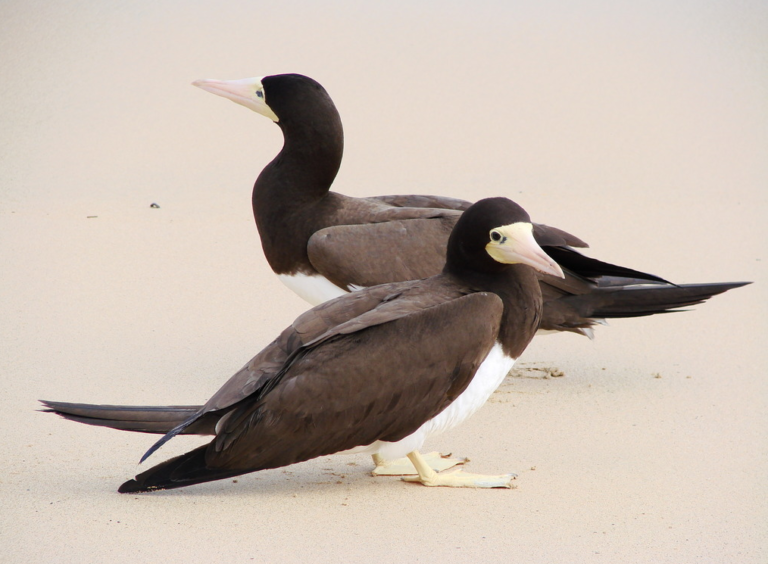
“Atlantic Booby”, S. l. leucogaster, females. (Fernando de Noronha, Brazil; December 4, 2009.) © Rafael Ritter

“Atlantic Booby”, S. l. leucogaster, female. (Fernando de Noronha, Brazil; February 27, 2014.) © Luiz Kagiyama
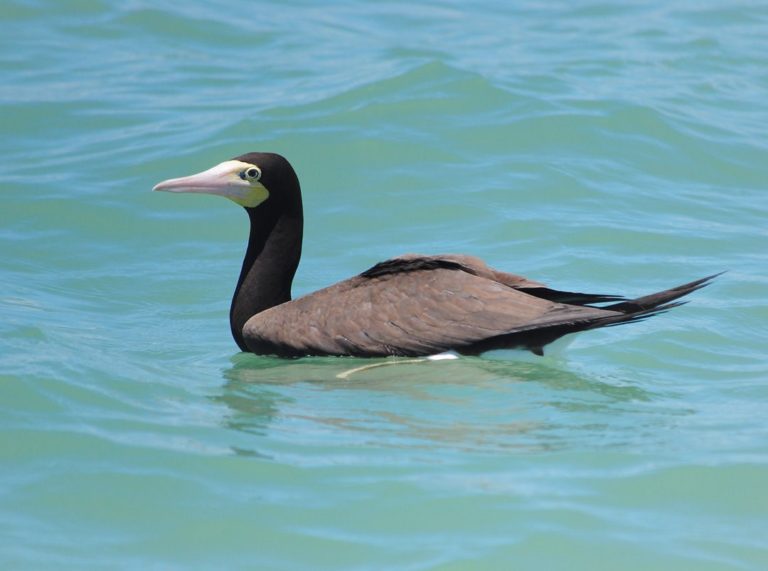
“Atlantic Booby”, S. l. leucogaster, female. (Nova Viçosa, Bahia, Brazil; February 16, 2009.) © Fernando Araújo
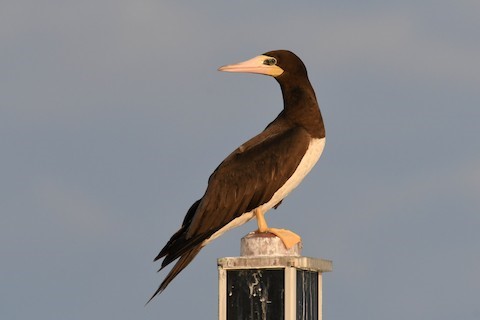
“Atlantic Booby”, S. l. leucogaster, female. (Chesapeake Bay, north of Love Point, Kent Island, Maryland; August 4, 2019.) © Sam Miller

“Atlantic Booby”, S. l. leucogaster, adult (sex indeterminate) on nest with chick. (Tinhosa Grande, Príncipe, São Tomé & Príncipe; February 14, 2013.) © Simon Valle
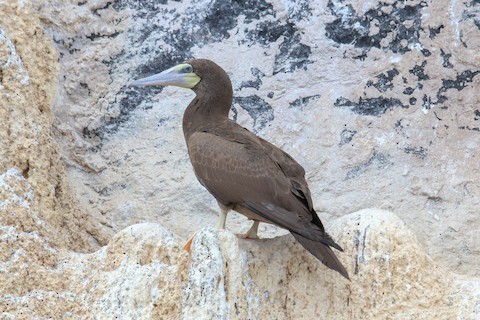
“Atlantic Booby”, S. l. leucogaster, sex indeterminate. (Egg Island, St. Helena; December 16, 2019.) © Allison Miller
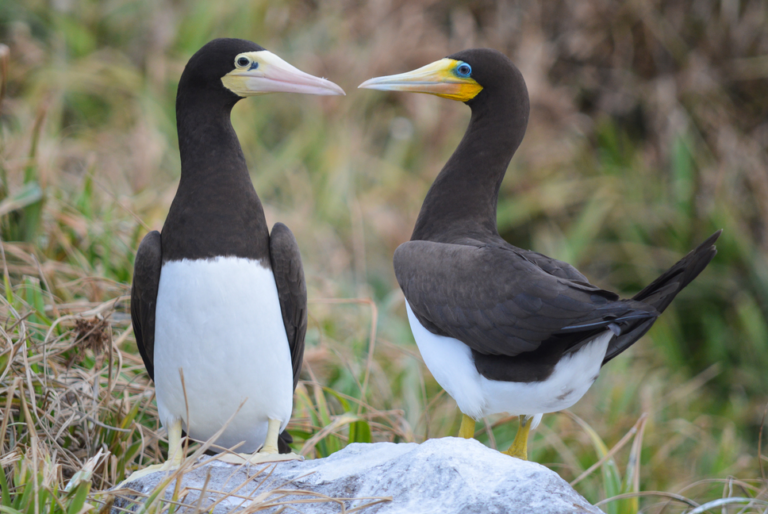
“Atlantic Booby”, S. l. leucogaster, female and male—note female’s paler, whiter feet and facial skin, and compare female’s yellow orbital skin with the male’s vivid blue. (Ilha de Currais, Paraná, Brazil; February 21, 2014.) © Raphael Nunes

“Atlantic Booby”, S. l. leucogaster, female and male—note the female’s pinkish bill contrasting with the male’s horn-colored, bluish tinted bill. (Cayman Brac; November 18, 2010.) © Brian Davis
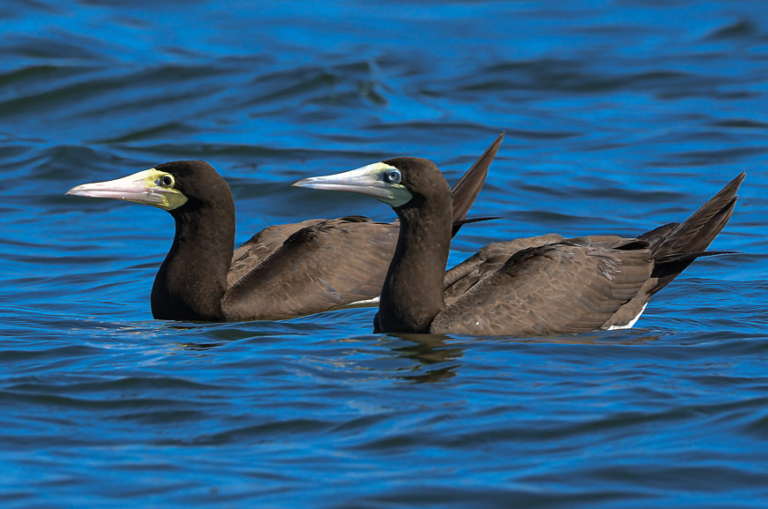
“Atlantic Booby”, S. l. leucogaster, female and male—this pair is atypical in that the female has more orangish facial skin, but the sexes can be differentiated by the color of the orbital skin, which is bluish on the male versus yellow on the female, and the bill, which is pink on the female versus grayish on the male. (Guaraqueçaba, Paraná, Brazil; May 15, 2018.) © Margi Moss
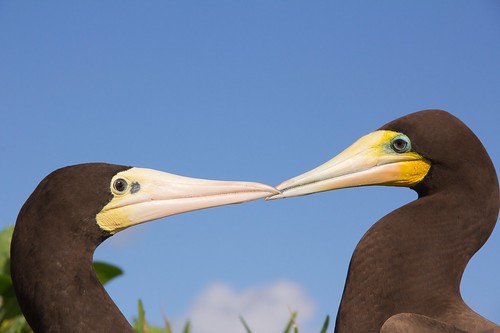
“Atlantic Booby”, S. l. leucogaster, female and male. (Ilhas Abrolhos, Bahia, Brazil; July 5, 2014.) © Luana Bianquini
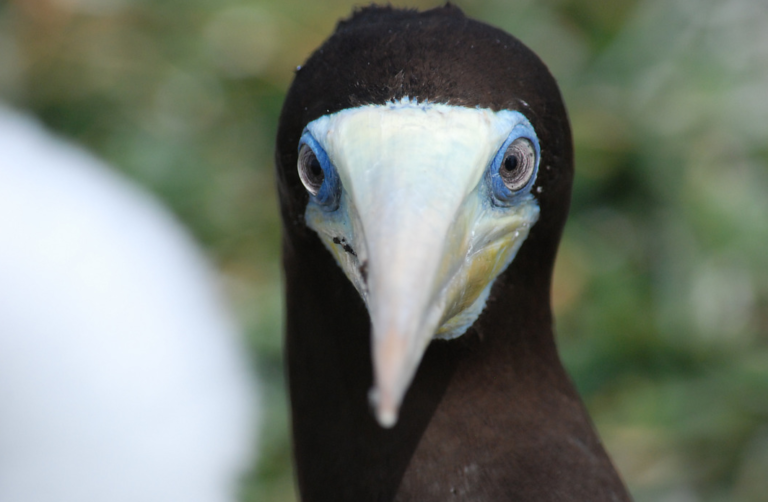
“Atlantic Booby”, S. l. leucogaster, male. (Brazil; July 20, 2019.) © Rafaela Bisacchi

“Atlantic Booby”, S. l. leucogaster, female. (Courtney Campbell Causeway, Tampa, Florida; February 7, 2018.) © Bob Lane
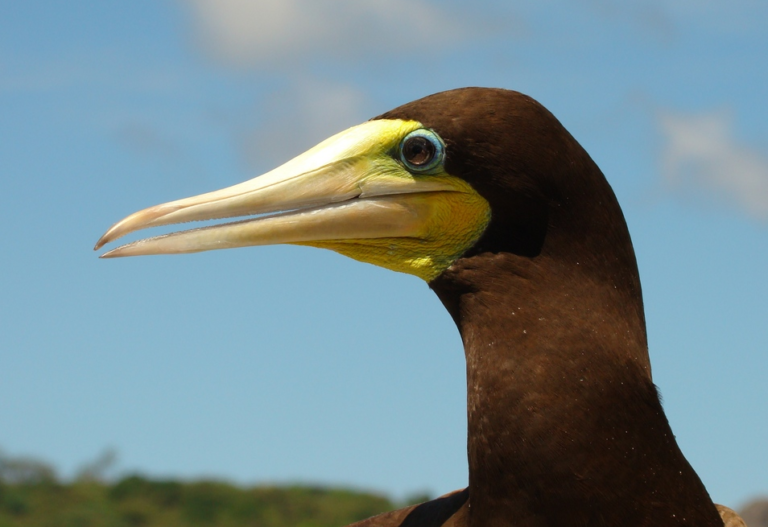
“Atlantic Booby”, S. l. leucogaster, male. (Fernando de Noronha, Brazil; March 22, 2011.) © Rafael Antunes Dias

“Atlantic Booby”, S. l. leucogaster, female. (Fernando de Noronha, Brazil; April 27, 2017.) © Robson Czaban
In flight, viewed dorsally, the upperparts are all-brown, but the head and neck usually appear darker, contrasting with the rest.
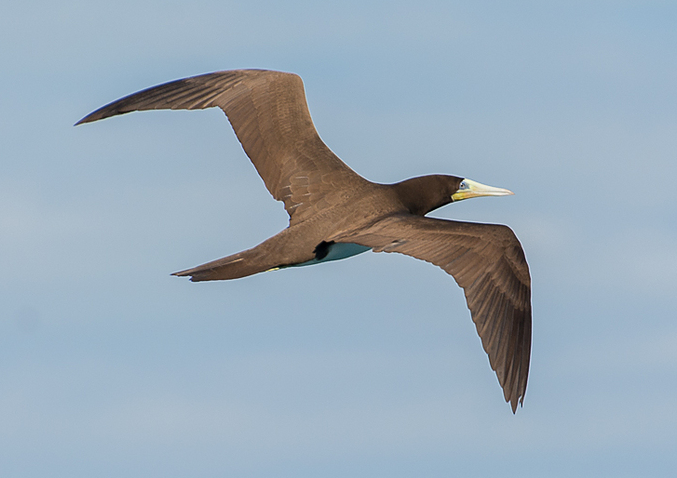
“Atlantic Booby”, S. l. leucogaster, male showing darker hood contrasting with paler-brown upperparts. (Florianópolis, Santa Catarina, Brazil; July 26, 2014.) © Rodrigo von Mühlen
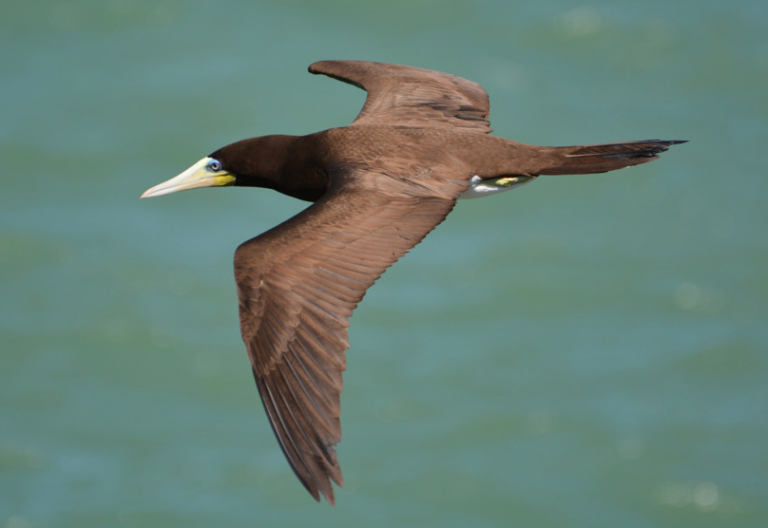
“Atlantic Booby”, S. l. leucogaster, male showing darker hood contrasting with paler-brown upperparts. (Cabo Frio, Rio de Janeiro, Brazil; September 12, 2017.) © Carlos Timm
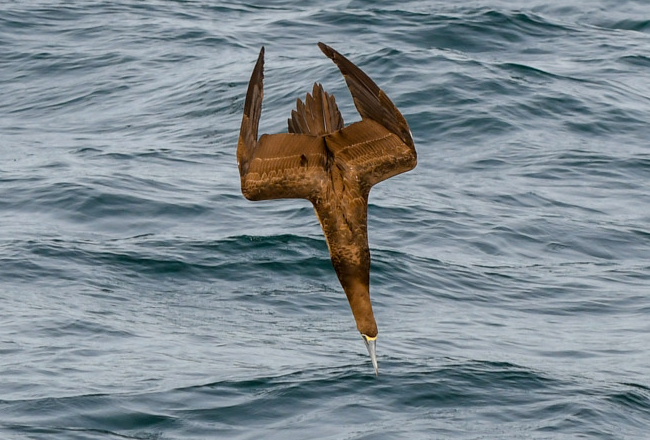
“Atlantic Booby”, S. l. leucogaster, in mid-dive about to enter the water. (Balneário Piçarras, Santa Catarina, Brazil; August 5, 2018.) © João Encarnação
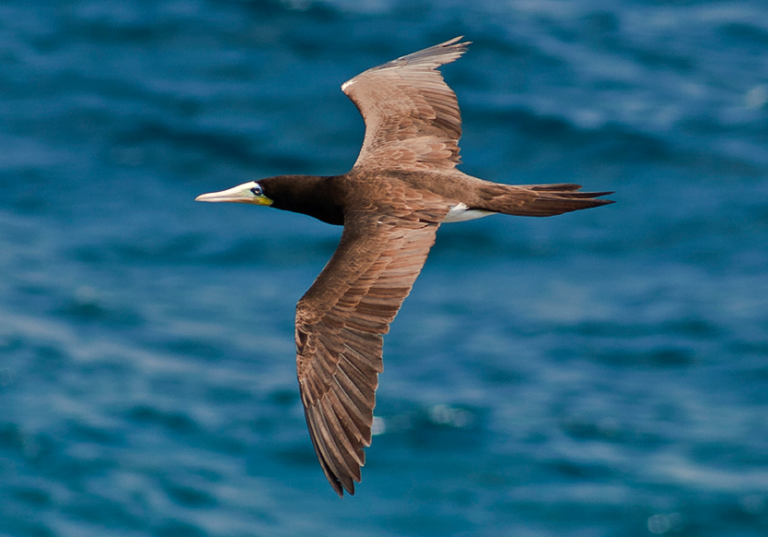
“Atlantic Booby”, S. l. leucogaster, male showing darker hood contrasting with paler-brown upperparts. (Fernando de Noronha, Brazil; October 6, 2010.) © Luis Cesar Paiva
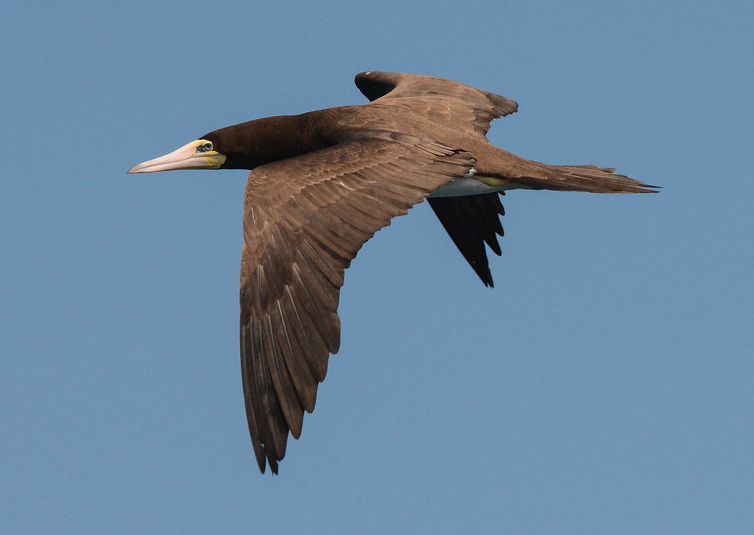
“Atlantic Booby”, S. l. leucogaster, female showing darker hood contrasting with paler-brown upperparts. (Peruíbe, São Paulo, Brazil; August 24, 2014.) © Guto Balieiro

“Atlantic Booby”, S. l. leucogaster, female. (Maho Beach, St. Maarten; November 26, 2008.) © Knut Hansen
Viewed ventrally, the underwing is mostly dark-brown with contrasting bright-white coverts that extend out to the wrist—but typically with a wider brown bar on the leading edge starting midway along the secondaries. Within these coverts, the middle row is whiter than the outer, trailing row. This difference in shading is usually detectable only in photographs, but it is typically a pronounced difference. (Overall, the extent of white on “Atlantic’s” underwing coverts is about intermediate between the whiter “Forster’s” and darker “Brewster’s”.)
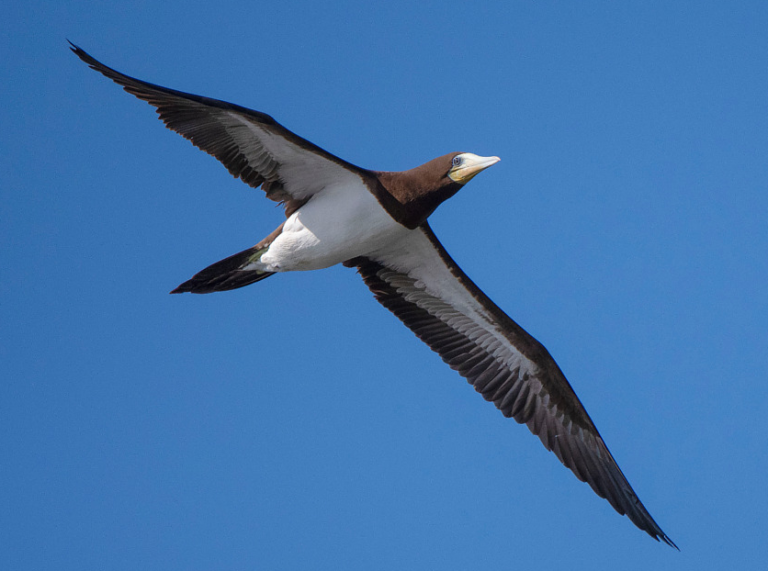
“Atlantic Booby”, S. l. leucogaster, male showing characteristic underwing pattern. (Cananéia, São Paulo, Brazil; August 29, 2020.) © Carlos Moura
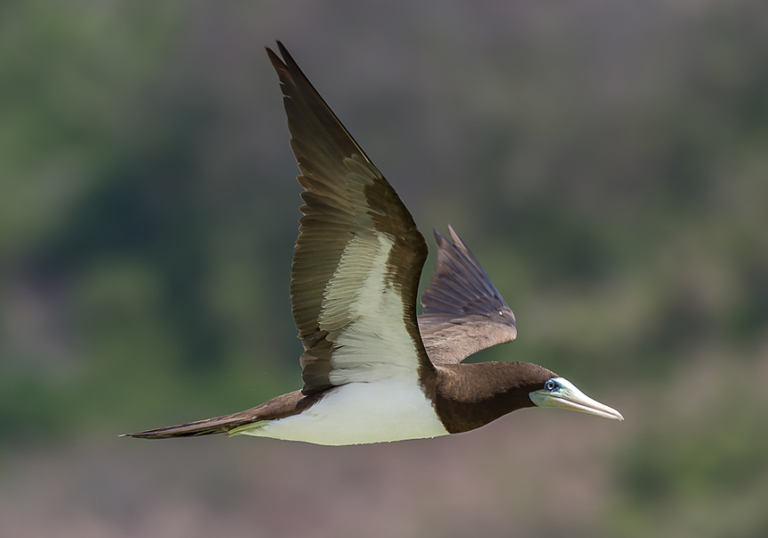
“Atlantic Booby”, S. l. leucogaster, male showing characteristic underwing pattern. (Fernando de Noronha, Brazil; December 18, 2016.) © Celso B. Almeida

“Atlantic Booby”, S. l. leucogaster, male showing characteristic underwing pattern. (Fajardo, Puerto Rico; March 29, 2013.) © Eric Hynes

“Atlantic Booby”, S. l. leucogaster, male in a dramatic aerial posture, showing characteristic underwing pattern. (Laguna, Santa Catarina, Brazil; August 15, 2013.) © Orlando Machado

“Atlantic Booby”, S. l. leucogaster, male showing characteristic underwing pattern. (São Vicente, São Paulo, Brazil; June 8, 2019.) © Luiz Frare

“Atlantic Booby”, S. l. leucogaster, male showing characteristic underwing pattern. (Praia Grande, Rio de Janeiro, Brazil; August 8, 2017.) © David Steinwender
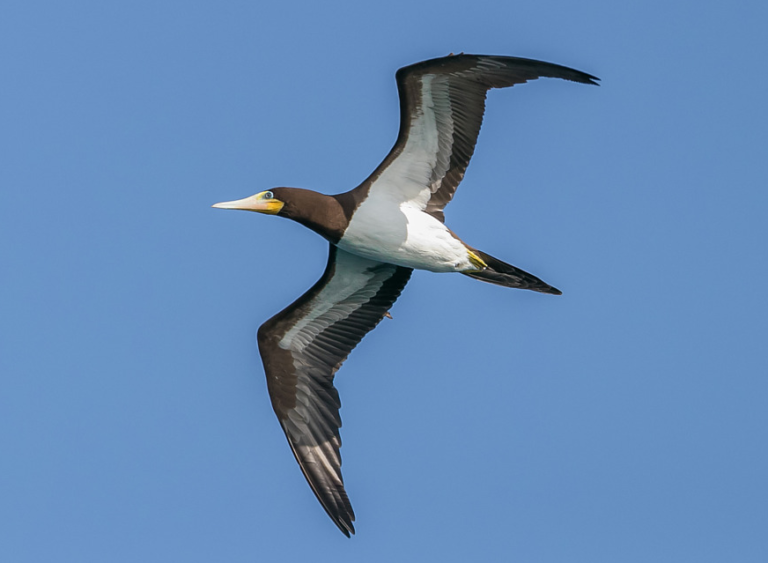
“Atlantic Booby”, S. l. leucogaster, male showing characteristic underwing pattern. (Ilha Queimada Pequena, São Paulo, Brazil; July 25, 2020.) © Eduardo Bergo
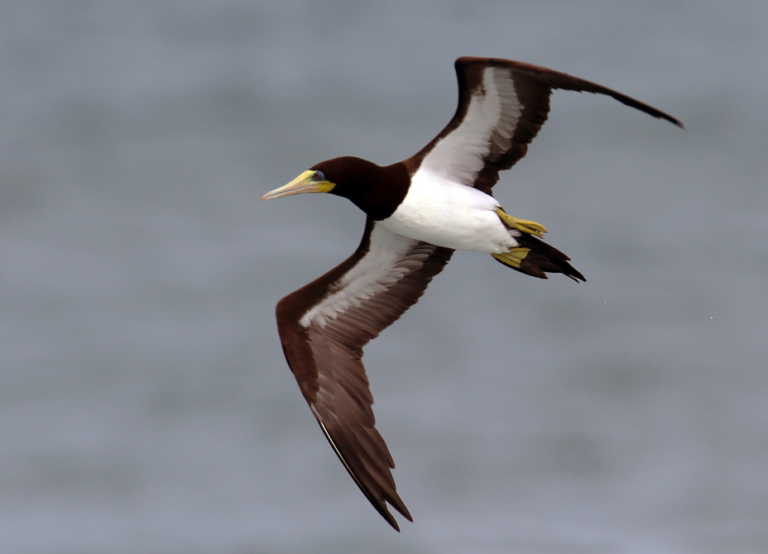
“Atlantic Booby”, S. l. leucogaster, male showing characteristic underwing pattern. (Florianópolis, Santa Catarina, Brazil; June 20, 2015.) © Paulo Fernando Bertagnolli
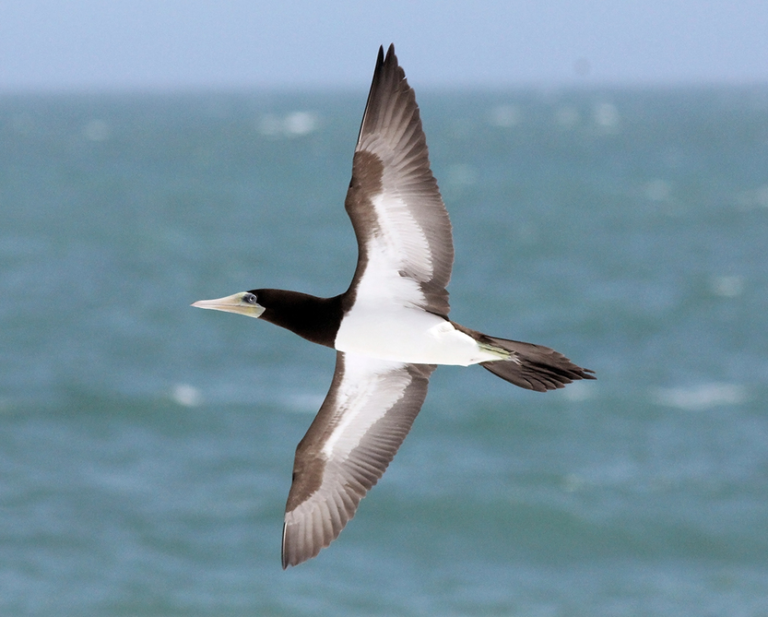
“Atlantic Booby”, S. l. leucogaster, sex indeterminate, in strong lighting which makes the underwing appear whiter then usual. (Praia de Itaipuaçu, Maricá, Rio de Janeiro, Brazil; November 3, 2013.) © Sávio Bruno
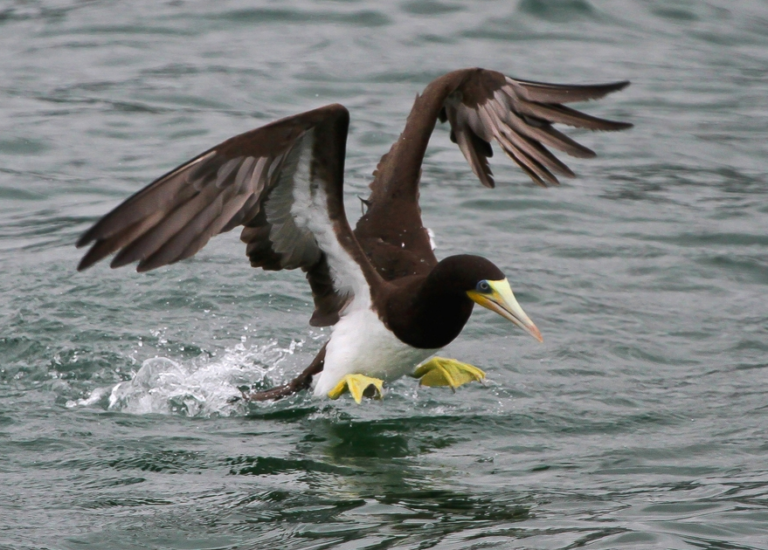
“Atlantic Booby”, S. l. leucogaster, male. (Florianópolis, Santa Catarina, Brazil; December 19, 2012.) © Oscar Abener Fenalti
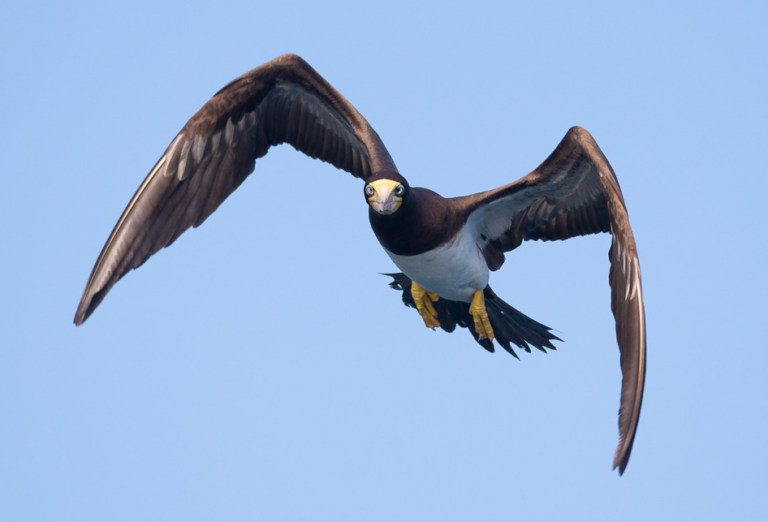
“Atlantic Booby”, S. l. leucogaster, male. (Ilhabela, São Paulo, Brazil; September 9, 2018.) © Octavio Campos Salles
Immature Plumages. Before attaining full adult plumage, “Atlantic Boobies” go through a progression of changes in plumage and bare parts coloration.
Juveniles are almost entirely medium-to-dark brown with a dark-gray bill and facial skin.
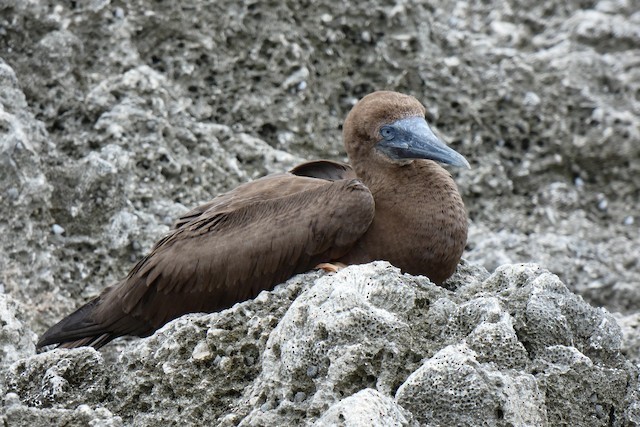
“Atlantic Booby”, S. l. leucogaster, juvenile. (West Bay, Grand Cayman; October 7, 2018.) © Danielle Bouchard

“Atlantic Booby”, S. l. leucogaster, juvenile. (St. Augustine Beach, Florida; March 20, 2015.) © David W. Foster

“Atlantic Booby”, S. l. leucogaster, juvenile. (Pleasure Island, Port Arthur, Texas; January 30, 2020.) © Albert Ribes
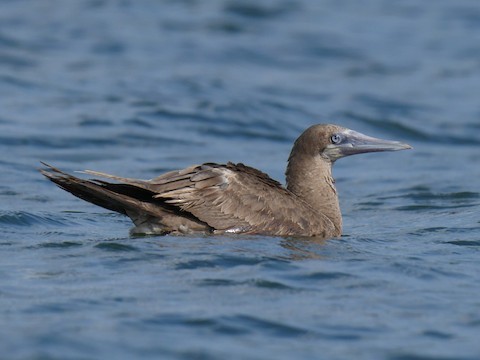
“Atlantic Booby”, S. l. leucogaster, juvenile. (Lake Onota, Pittsfield, Massachusetts; August 17, 2018.) © Linda Merry

“Atlantic Booby”, S. l. leucogaster, juvenile. (Cape May, New Jersey; September 26, 2018.) © Jerald Reb
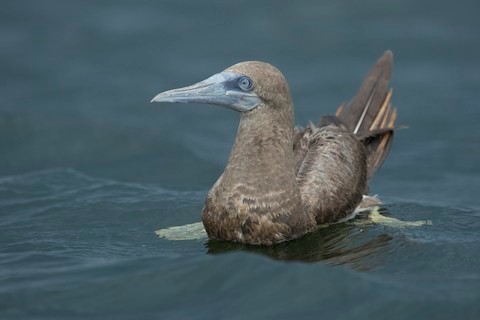
“Atlantic Booby”, S. l. leucogaster, juvenile. (Nimisila Reservoir, Summit County, Ohio; August 27, 2020.) © Greg Pasek
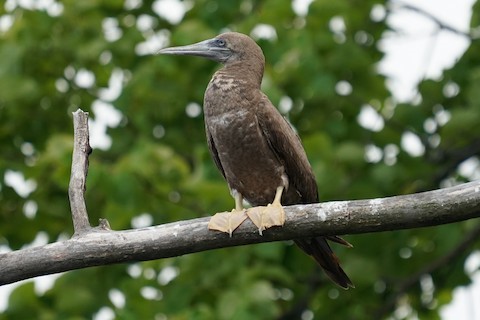
“Atlantic Booby”, S. l. leucogaster, juvenile. (Nimisila Reservoir, Summit County, Ohio; August 27, 2020.) © Martin Carlin
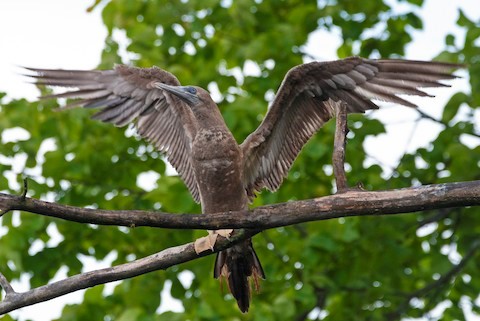
“Atlantic Booby”, S. l. leucogaster, juvenile showing almost uniformly dark underwings. (Nimisila Reservoir, Summit County, Ohio; August 29, 2020.) © Andrew Simon
As they age, the belly and underwing linings become progressively whiter, and the bill and facial skin lighten. A pronounced line of demarcation between the solid brown chest and paler (eventually white) belly is noticeable at all stages after juvenile.
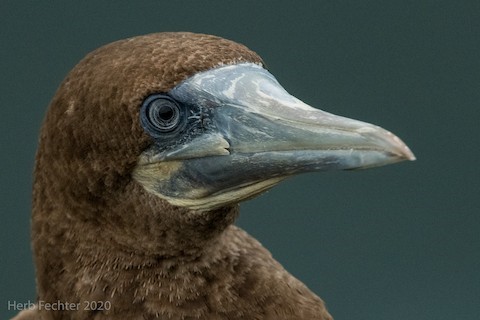
“Atlantic Booby”, S. l. leucogaster, immature. (Lake Strom Thurmond Overlook, Clarks Hill, South Carolina; September 17, 2020.) © Herb Fechter
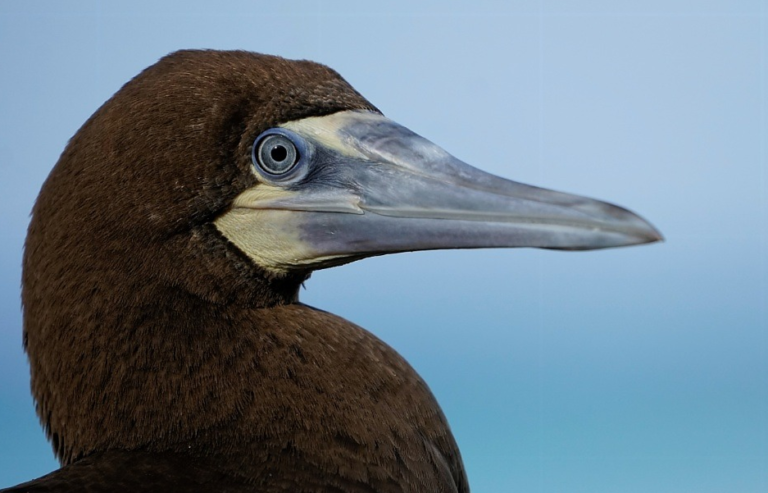
“Atlantic Booby”, S. l. leucogaster, immature. (Fernando de Noronha, Brazil; December 12, 2018.) © Daniel Alfenas
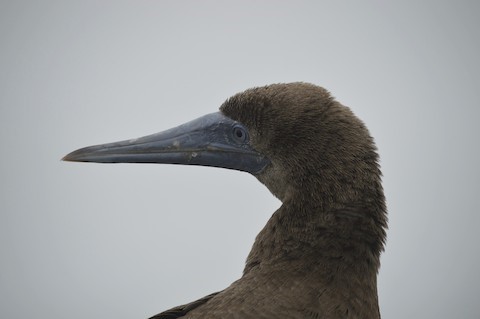
“Atlantic Booby”, S. l. leucogaster, juvenile. (St. Augustine Beach, Florida; March 20, 2015.) © David W. Foster
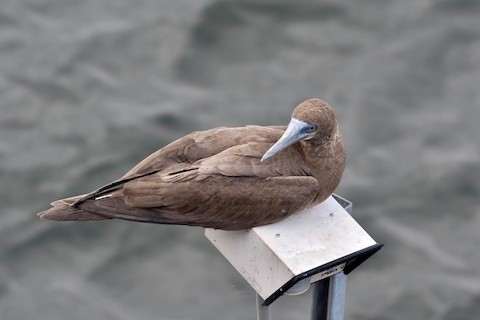
“Atlantic Booby”, S. l. leucogaster, immature. (Lake Strom Thurmond Overlook, Clarks Hill, South Carolina; September 18, 2020.) © Brad Sale
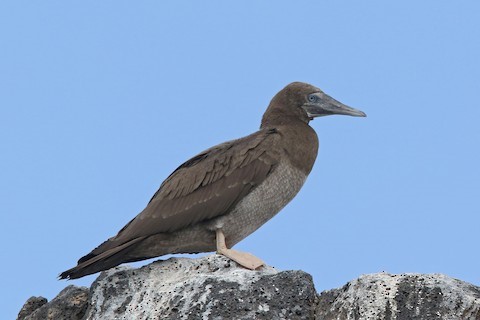
“Atlantic Booby”, S. l. leucogaster, immature. (Ilhéu Raso, Cape Verde; March 20, 2018.) © Volker Hesse
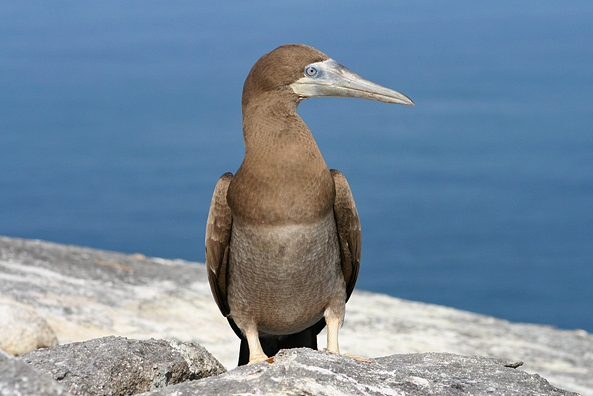
“Atlantic Booby”, S. l. leucogaster, immature. (Itanhaém, São Paulo, Brazil; August 23, 2007.) © Arthur Macarrão
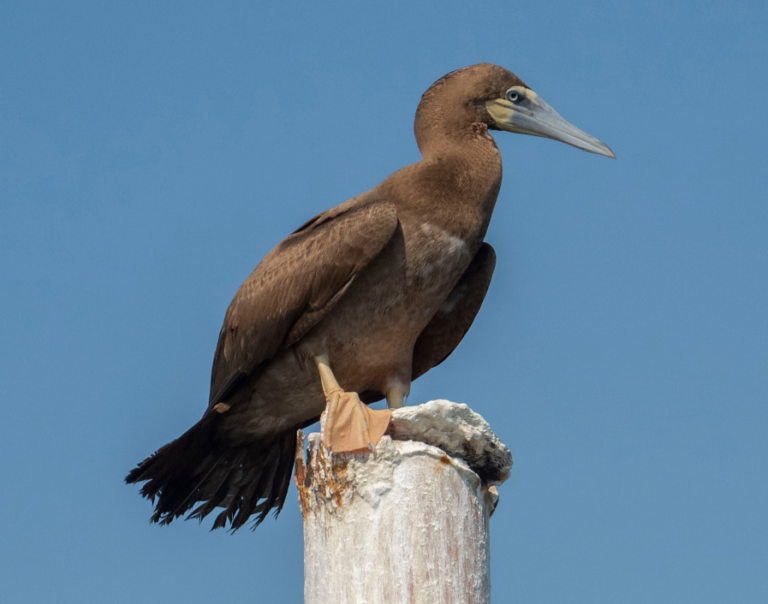
“Atlantic Booby”, S. l. leucogaster, immature. (Guapimirim, Rio de Janeiro, Brazil; October 2, 2020.) © Gustavo Quintanilha
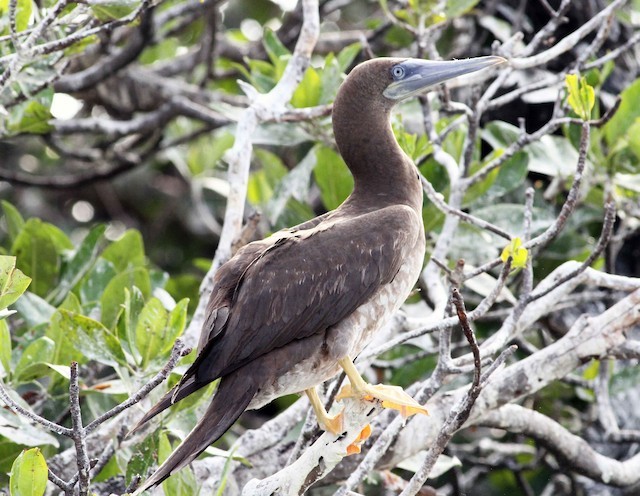
“Atlantic Booby”, S. l. leucogaster, immature. (Man-O’-War Caye, Belize; February 27, 2017.) © Cindy Franklin

“Atlantic Booby”, S. l. leucogaster, immature. (Laje de Santos State Marine Park, São Paulo, Brazil; November 26, 2014.) © Francisco Luiz Vicentini Neto
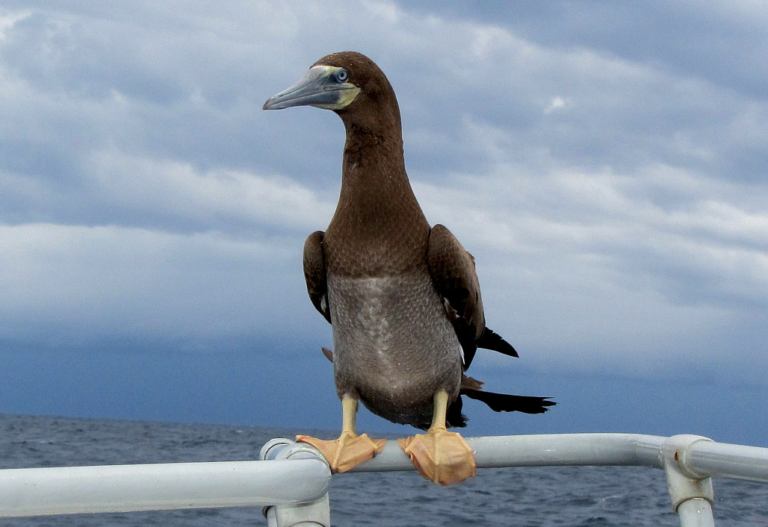
“Atlantic Booby”, S. l. leucogaster, immature. (Ilhabela, São Paulo, Brazil; January 17, 2014.) © Matias Gomes

“Atlantic Booby”, S. l. leucogaster, immature. (Doniphan, Missouri; August 11, 2020.) © Pete Monacell

“Atlantic Booby”, S. l. leucogaster, subadult male. (Ilhabela, São Paulo, Brazil; June 25, 2020.) © Octavio Campos Salles

“Atlantic Booby”, S. l. leucogaster, subadult. (Cananéia, São Paulo, Brazil; March 14, 2011.) © Isabel Pellizzer

“Atlantic Booby”, S. l. leucogaster, subadult female. (Balneário Piçarras, Santa Catarina, Brazil; July 26, 2012.) © Sérgio Messias
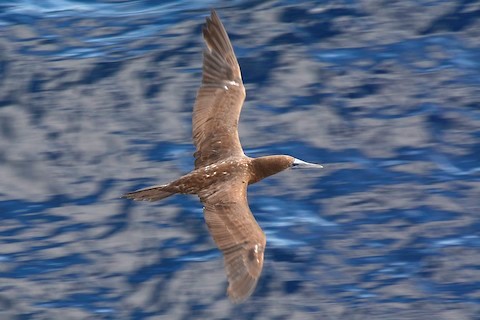
“Atlantic Booby”, S. l. leucogaster, immature. (Offshore from Castries, St. Lucia; March 28, 2018.) © Luiz Moschini
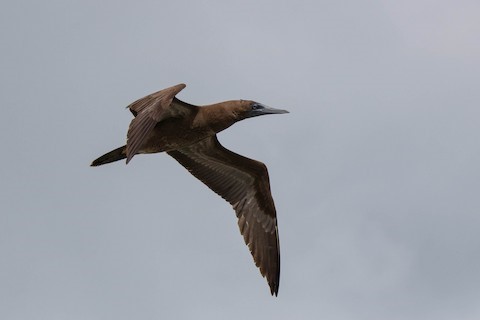
“Atlantic Booby”, S. l. leucogaster, juvenile. (Belize City, Belize; January 23, 2020.) © Hernan Riverol
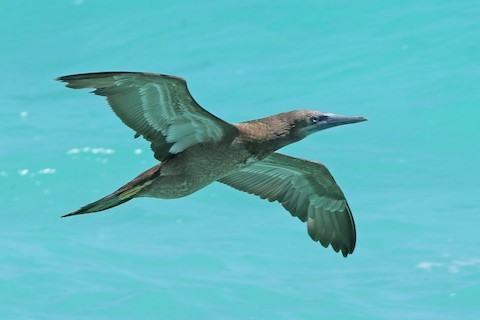
“Atlantic Booby”, S. l. leucogaster, immature. (Cabo Rojo, Dominican Republic; April 11, 2019.) © Volker Hesse
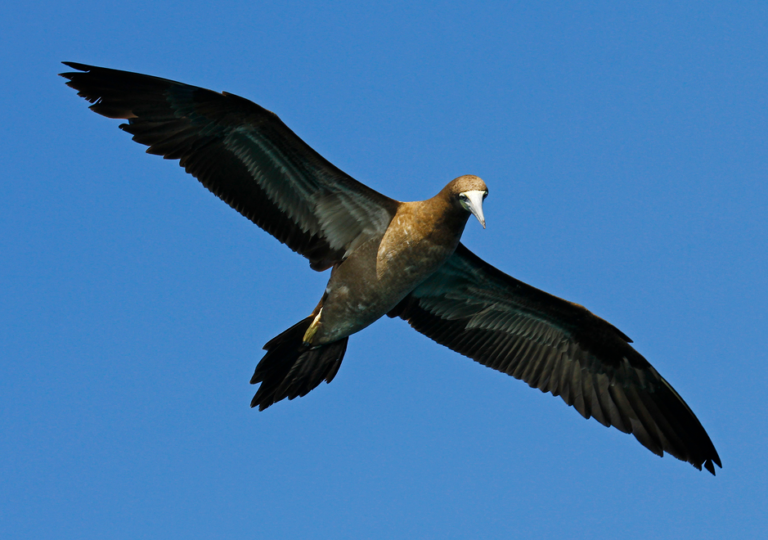
“Atlantic Booby”, S. l. leucogaster, immature. (Florianópolis, Santa Catarina, Brazil; August 2, 2015.) © Carmen Lúcia Bays Figueiredo

“Atlantic Booby”, S. l. leucogaster, subadult female. (St. Thomas, U.S. Virgin Islands; September 27, 2005.) © Dale Pate

“Atlantic Booby”, S. l. leucogaster, immature showing yellow feet. (Fernando de Noronha, Brazil; December 18, 2016.) © Celso B. Almeida

“Atlantic Booby”, S. l. leucogaster, immature. (Lynchburg Ferry, Channelview, Texas; June 2, 2020.) © Letha Slagle
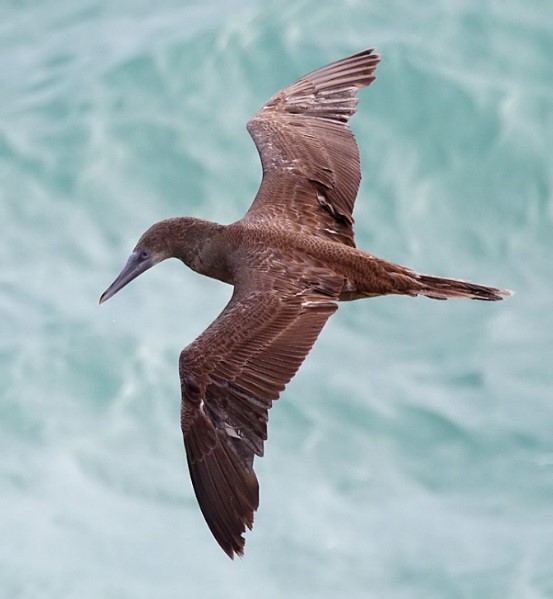
“Atlantic Booby”, S. l. leucogaster, juvenile. (Cabo Rojo, Puerto Rico; January 30, 2010.) © Steve Metz

“Atlantic Booby”, S. l. leucogaster, immature, showing crisp contrast between darker hood and paler upperparts. (Offshore from Biscayne Bay, Florida; September 13, 2020.) © Robert Gundy

“Atlantic Booby”, S. l. leucogaster, immature. (Ilhabela, São Paulo, Brazil; October 19, 2019.) © Silvia Faustino Linhares

“Atlantic Booby”, S. l. leucogaster, immature. (Offshore from Martinique; March 2, 2018.) © Brian Sullivan
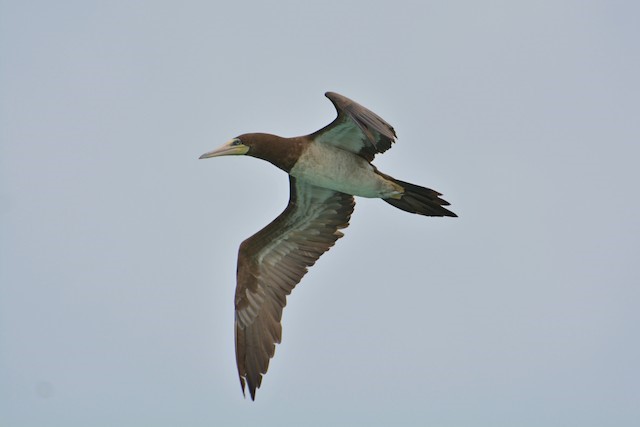
“Atlantic Booby”, S. l. leucogaster, subadult female. (Arraial do Cabo, Rio de Janeiro, Brazil; January 8, 2018.) © Oliver Prioli
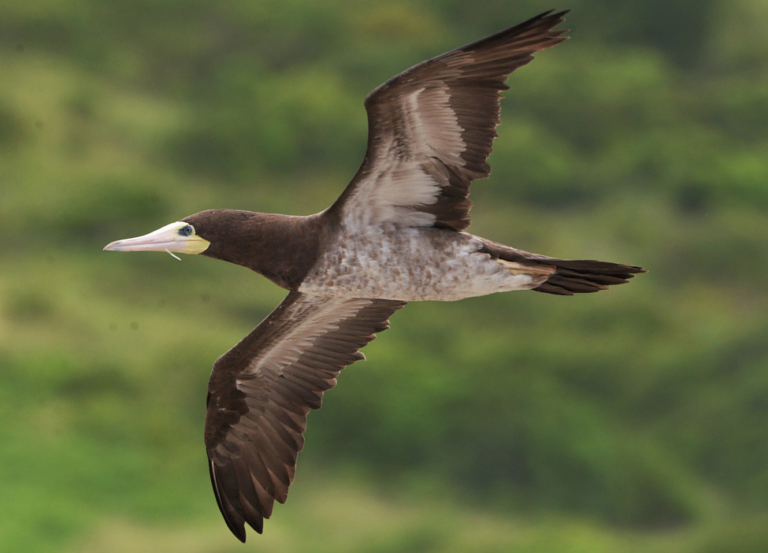
“Atlantic Booby”, S. l. leucogaster, immature female. (Fernando de Noronha, Brazil; April 12, 2019.) © Julio Machado
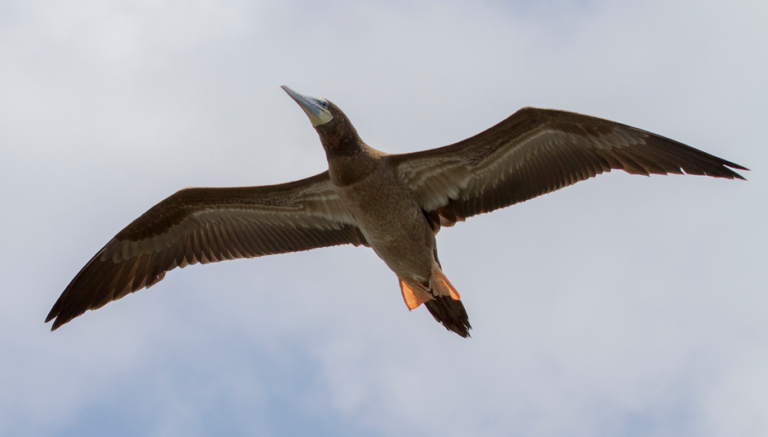
“Atlantic Booby”, S. l. leucogaster, immature. (Joinville, Santa Catarina, Brazil; February 4, 2014.) © Osni Sidnei Munhoz
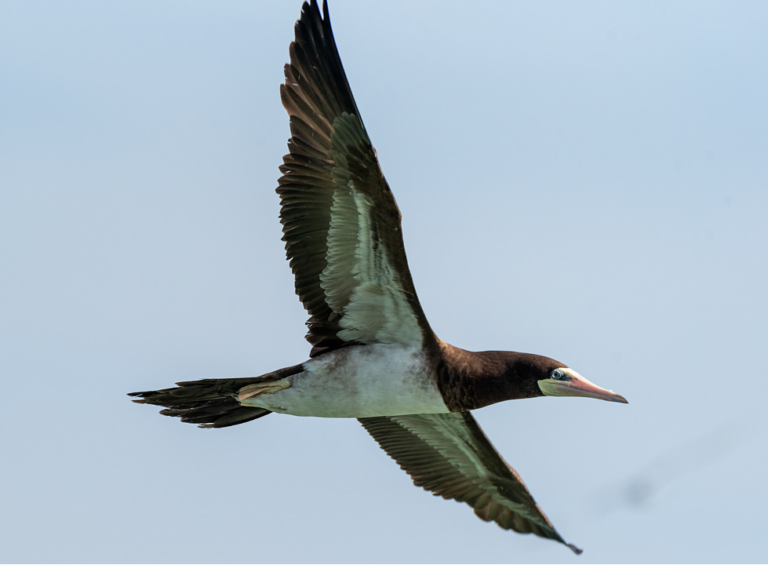
“Atlantic Booby”, S. l. leucogaster, subadult male. (Balneário Piçarras, Santa Catarina, Brazil; July 5, 2020.) © Marcos Guirado

“Atlantic Booby”, S. l. leucogaster, subadult female. (Offshore from Peniche, Portugal; December 3, 2017.) © PMDE Esteves

“Atlantic Booby”, S. l. leucogaster, subadult female. (Hogsty Reef, Bahamas; May 22, 2019.) © Hannes Leonard
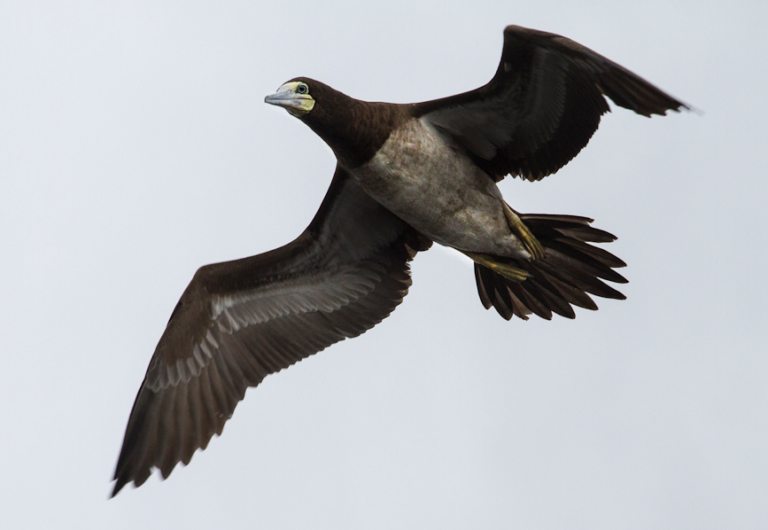
“Atlantic Booby”, S. l. leucogaster, immature female. (Cananéia, São Paulo, Brazil; July 15, 2012.) © Pepe Mélega

“Atlantic Booby”, S. l. leucogaster, immature. (Cabo Frio, Rio de Janeiro, Brazil; July 18, 2013.) © Karoline França
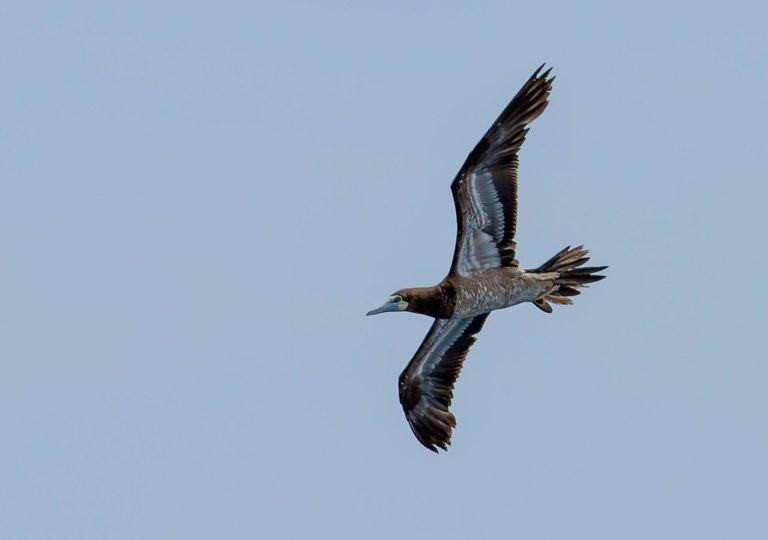
“Atlantic Booby”, S. l. leucogaster, immature. (Salvador, Bahia, Brazil; December 6, 2014.) © Vítor Barbosa
Cf. “Forster’s Booby”. “Atlantic” and “Forster’s” Boobies are extremely similar but rarely if ever overlap. “Atlantic” is known only from the Atlantic Ocean and “Forster’s” is known only from the Indian and Pacific Oceans, but both are highly mobile and could occur nearly anywhere.
Male “Atlantic” and “Forster’s” have approximately the same plumage but are fairly easy to distinguish by the color of their facial skin: orange on “Atlantic” (with blue around the eyes) versus all-blue on “Forster’s”. Their foot color also differs: usually orangish-yellow on “Atlantic” versus greenish-yellow on “Forster’s”.
Even with clear, high-resolution images, female Brown Boobies are not always assignable to a particular form. To distinguish female “Atlantic” and “Forster’s”, the key features are the coloration of the bill, facial skin, and feet:
Bill Color: Female “Atlantic” has a consistently pinkish bill, whereas “Forster’s” tends to appear more yellowish or ivory—although some may have a pinkish hue.
Facial Skin and Foot Color: Female “Atlantic” typically shows yellow facial skin and feet, whereas “Forster’s” appears closer to white or greenish-yellow.
Immatures are very difficult to distinguish, in part because they vary as they age and molt. However, the underwing coverts seem to differ consistently: “Forster’s” shows extensively whitish underwing coverts while its belly is still dark, whereas “Atlantic’s” underwing coverts and belly generally match one another at each molt stage. Immature “Atlantic’s” feet tend to be yellower, or more orangish, while immature “Forster’s” has either gray, whitish, or pale greenish-yellow feet.
Cf. “Brewster’s Booby”. “Brewster’s” and “Atlantic” Boobies can be extremely similar. They are not known to overlap regularly, but may occasionally stray into one another’s ranges along coasts of Middle America, and both occasionally stray into the interior of North America. Adult male “Brewster’s” is easily recognized by its pale head, but females and immatures are so similar as to be indistinguishable in most cases.
Even with clear, high-resolution images, female Brown Boobies are not always assignable to a particular form. To distinguish female “Brewster’s” and “Atlantic”, the key features are bare parts coloration (facial skin and feet), bill size, and underwing pattern:
Facial Skin and Foot Color: Female “Atlantic” typically shows yellow facial skin and feet, whereas “Brewster’s” appears closer to white or greenish-yellow. Male “Atlantic” can best be distinguished from females of both forms by its blue orbital skin amid otherwise orangish-yellow facial skin, as well as orangish-yellow feet.
Bill Size: “Brewster’s” is slightly smaller than “Atlantic” and its bill averages somewhat thinner. This difference is probably too slight to be useful except at the extremes.
Underwing Coverts: On average, “Brewster’s” has more limited white underwing coverts, with a more pronounced dark spur or stripe that projects from the wrist area toward the body. However, both forms vary to some to extent, and younger birds tend to retain darker coverts. Underwing pattern is most useful when the coverts appear all-white, because this effectively rules out “Brewster’s”.
Cf. Red-footed Booby. Dark morph Red-footed Boobies, which predominate in some populations—especially in the eastern Pacific—can be all-brown, and the juveniles in particular strongly resemble juvenile and immature Brown Boobies.
Typically, juvenile Brown Boobies are darker than these Red-footeds and more uniformly colored above and below. Immature Browns become distinctive as the belly lightens because the lightened area is sharply defined, matching the adult plumage.
Most juvenile Red-footed Boobies have a perceptibly darker breastband. As they age, dark morph Red-footed Boobies turn coffee-colored rather than dark brown.
Cf. Other Juvenile Boobies. Juvenile Masked, Nazca, and Blue-footed Boobies have roughly the same pattern as adult Brown Boobies, for which they are often mistaken. Under suboptimal viewing conditions they can be indistinguishable, but if seen clearly the crisp bicolored plumage of adult Brown Boobies is unique.
Notes
Polytypic form consisting of two subspecies (brewsteri and etesiaca), one of three distinct forms of Brown Booby (S. leucogaster), which are sometimes regarded as separate species (e.g., Howell and Zufelt 2019).
References
Alderfer, J., and J.L. Dunn. 2014. National Geographic Complete Birds of North America (Second Edition). National Geographic Society, Washington, D.C.
Ascanio, D., G.A. Rodriguez, and R. Restall. 2017. Birds of Venezuela. Christopher Helm, London.
BirdLife International. 2018. Sula leucogaster. The IUCN Red List of Threatened Species 2018: e.T22696698A132590197. https://dx.doi.org/10.2305/IUCN.UK.2018-2.RLTS.T22696698A132590197.en. (Accessed July 6, 2021.)
eBird. 2021. eBird: An online database of bird distribution and abundance. Cornell Lab of Ornithology, Ithaca, N.Y. http://www.ebird.org. (Accessed July 6, 2021.)
Fagan, J., and O. Komar. 2016. Peterson Field Guide to the Birds of Northern Central America. Houghton Mifflin Harcourt, New York.
ffrench, R. 2012. A Guide to the Birds of Trinidad & Tobago (Third Edition). Cornell University Press.
Garcia-del-Rey, E. 2011. Field Guide to the Birds of Macaronesia: Azores, Madeira, Canary Islands, Cape Verde. Lynx Editions, Barcelona.
Garcia-del-Rey, E. 2018. Birds of the Canary Islands. Christopher Helm, London.
Garrigues, R., and R. Dean. 2014. The Birds of Costa Rica: A Field Guide (Second Edition). Cornell University Press.
Harrison, P. 1983. Seabirds: An Identification Guide. Houghton Mifflin, Boston.
Howell, S.N.G., and S. Webb. 1995. A Guide to the Birds of Mexico and Northern Central America. Oxford University Press.
Howell, S.N.G., and K. Zufelt. 2019. Oceanic Birds of the World. Princeton University Press.
Kirwan, G.M., A. Levesque, M. Oberle, and C.J. Sharpe. 2019. Birds of the West Indies. Lynx Edicions, Barcelona.
Lee, D.S. and W.A. Mackin. 2009. Brown Booby. West Indian Breeding Seabird Atlas. http://www.wicbirds.net/brbo.html. (Posted April 7, 2009. Accessed July 6, 2021.)
McMullan, M., and T. Donegan. 2014, Field Guide to the Birds of Colombia (Second Edition). Fundación Proaves de Colombia, Bogotá.
Mullarney, K., L. Svensson, D. Zetterström, and P.J. Grant. 1999. Birds of Europe. Princeton University Press.
Ridgely, R.S., and J.A. Gwynne. 1989. A Guide to the Birds of Panama (Second Edition). Princeton University Press.
van Perlo, B. 2009. A Field Guide to the Birds of Brazil. Oxford University Press.
Wells, J.V., and A.C. Wells. 2017. Birds of Aruba, Bonaire, and Curaçao. Cornell University Press.
Wikiaves. 2021. Atobá-pardo, https://www.wikiaves.com.br/wiki/atoba-pardo. (Accessed July 6, 2021.)
Xeno-Canto. 2021. Brown Booby – Sula leucogaster. https://www.xeno-canto.org/species/Sula-leucogaster. (Accessed July 6, 2021.)

